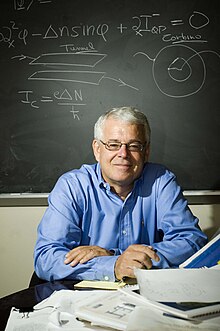Allan H. MacDonald (born December 1, 1951) is a theoretical condensed matter physicist and the Sid W. Richardson Foundation Regents Chair Professor of Physics at The University of Texas at Austin.[1][2][3][4] His research interests are centered on the electronic properties of electrons in metals and semiconductors.[5] He is well known for his work on correlated many-electron states in low-dimensional systems.[6] In 2020, he became one of the laureates of the Wolf Prize in Physics, for predicting the magic angle that turns twisted bilayer graphene into a superconductor.[3][7]
Allan H. MacDonald | |
|---|---|
 | |
| Born | December 1, 1951 Antigonish, Nova Scotia, Canada |
| Nationality | Canadian, American |
| Alma mater | St. Francis Xavier University, University of Toronto |
| Awards | Oliver E. Buckley Condensed Matter Prize (2007) Wolf Prize in Physics (2020) Citation Laureate (2024) |
| Scientific career | |
| Fields | Condensed matter physics |
| Institutions | University of Texas at Austin, Indiana University, National Research Council Canada |
| Doctoral advisor | S.H. Vosko |
| Website | https://web2.ph.utexas.edu/~macdgrp/ |
Education and early life
editHe was born in Antigonish, Nova Scotia, Canada, and attended local schools completing a B.S. at St. Francis Xavier University in 1973.[2][3] He completed his Ph.D.in physics at the University of Toronto in 1978, working with S.H. Vosko on relativistic generalizations of density functional theory, and on the application of density functional theory to magnetism in metals.[3]
Research and career
editPrior to joining the University of Texas, he worked at the Ottawa laboratory of the National Research Council Canada (1978–1987) and at Indiana University (1987–2000).[3][4] He has held visiting positions at the Swiss Federal Institute of Technology in Zurich and the Max Planck Institute for Solid State Research in Stuttgart, Germany.
MacDonald's research has focused on new or unexplained phenomena related to the quantum physics of interacting electrons in materials. He has contributed to theories of the integer and fractional quantum Hall effects, spintronics in metals and semiconductors, topological Bloch bands and momentum-space Berry curvature phenomena, correlated electron-hole fluids and exciton and polariton condensates, and two-dimensional materials.
In 2011 MacDonald and Rafi Bistritzer, a former postdoctoral researcher in MacDonald's lab, predicted that it would be possible to realize strong correlation physics in graphene bilayers twisted to a magic relative orientation angle,[8][9] foreshadowing the field of twistronics.[10] Pablo Jarillo-Herrero, an experimentalist at Massachusetts Institute of Technology, found that the magic angle resulted in the unusual electrical properties the UT Austin scientists had predicted.[11] At 1.1 degrees rotation at sufficiently low temperatures, electrons move from one layer to the other, creating a lattice and the phenomenon of superconductivity. The magic angle allows electric current to pass unimpeded, apparently without energy loss. This discovery could lead to more efficient electrical power transmission or new materials for quantum applications.[12]
His recent work is focused on anticipating new physics in moiré superlattices, and on achieving a full understanding of magic-angle bilayer graphene and transition-metal dichalcogenide moiré superlattice systems.
Honors and awards
editMacDonald received the Canadian Association of Physicists's Herzberg Medal in 1987,[2] the Oliver E. Buckley Prize of the American Physical Society in 2007 with James P. Eisenstein and Steven Girvin,[6] the Ernst Mach Honorary Medal of the Czech Academy of Sciences in 2012,[13] and the Wolf Prize in Physics in 2020 with Bistritzer and Jarrillo-Herrero.[3][7] He was elected to the American Academy of Arts and Sciences in 2005[4] and the National Academy of the Sciences in 2010.[5] He was named a 2024 Citation Laureate by Clarivate.[14]
Publications
editA list of Allan MacDonald's publications is available at Google Scholar.[15]
References
edit- ^ "MACDONALD, ALLAN H - Physics - CNS Directory". ph.utexas.edu. Retrieved 2023-07-02.
- ^ a b c "Allan MacDonald | Biography, Discoveries, Graphene, & Facts | Britannica". www.britannica.com. Retrieved 2024-09-24.
- ^ a b c d e f מיכל (2020-01-13). "Allan H. MacDonald". Wolf Foundation. Retrieved 2024-09-24.
- ^ a b c "Allan Hugh MacDonald | American Academy of Arts and Sciences". www.amacad.org. 2024-09-01. Retrieved 2024-09-24.
- ^ a b "Allan H. MacDonald – NAS". National Academy of Sciences. Retrieved 2024-09-24.
- ^ a b "Oliver E. Buckley Condensed Matter Physics Prize". www.aps.org. Retrieved 2024-09-24.
- ^ a b "UT professor wins prestigious Wolf Prize in physics for work in 'Twistronics'". Austin American-Statesman. 14 Jan 2020. Retrieved 29 Sep 2020.
- ^ Bistritzer, Rafi; MacDonald, Allan H. (26 July 2011). "Moiré bands in twisted double-layer graphene". Proceedings of the National Academy of Sciences. 108 (30): 12233–12237. arXiv:1009.4203. Bibcode:2011PNAS..10812233B. doi:10.1073/pnas.1108174108. PMC 3145708. PMID 21730173.
- ^ "New twist on graphene gets materials scientists hot under the collar". Chemistry World. 19 March 2019. Retrieved 29 Sep 2020.
- ^ "With a Simple Twist, a 'Magic' Material Is Now the Big Thing in Physics". Quanta Magazine. 30 April 2019. Retrieved 29 Sep 2020.
- ^ Cao, Yuan; Fatemi, Valla; Fang, Shiang; Watanabe, Kenji; Taniguchi, Takashi; Kaxiras, Efthimios; Jarillo-Herrero, Pablo (5 March 2018). "Unconventional superconductivity in magic-angle graphene superlattices". Nature. 556 (7699): 43–50. arXiv:1803.02342. Bibcode:2018Natur.556...43C. doi:10.1038/nature26160. PMID 29512651. S2CID 4655887.
- ^ "A Physics Magic Trick: Take 2 Sheets of Carbon and Twist". The New York Times. 30 October 2019. Retrieved 29 Sep 2020.
- ^ "Awarded The Ernst Mach Honorary Medals for Merit in the Physical Sciences - Akademie věd České republiky". www.avcr.cz. Retrieved 2024-09-24.
- ^ "Clarivate Reveals Citation Laureates 2024". Clarivate. Retrieved 2024-09-26.
- ^ "Allan H. MacDonald - Google Scholar". scholar.google.com. Retrieved 2024-10-07.